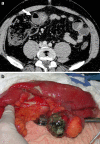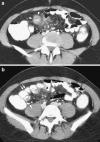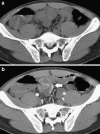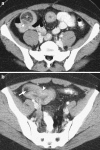Computed tomography of complicated Meckel's diverticulum in adults: a pictorial review
- PMID: 22347905
- PMCID: PMC3259399
- DOI: 10.1007/s13244-010-0017-8
Computed tomography of complicated Meckel's diverticulum in adults: a pictorial review
Abstract
OBJECTIVE: To show various CT aspects of complicated Meckel's diverticulum in adult patients to facilitate the preoperative diagnosis of this rare pathology in emergency settings. METHODS: A computer search of medical records over a 15 year period identified 23 adult patients who underwent surgery for acute abdomen generated by a complicated Meckel's diverticulum. CT images available for review were analyzed, and some specific patterns leading to the diagnosis of complicated Meckel's diverticulum are presented in this review. RESULTS: Complications were related to inflammation (14 patients), bleeding (5 patients), intestinal obstruction (3 patients), and penetrating foreign body (1 patient). The presence of a Meckel's diverticulum was usually suggested at CT scan by an abnormal outpouching, blind-ending digestive structure connected to the terminal ileum by a neck of variable caliber. Depending on the type of complications, the diverticulum was surrounded by mesenteric inflammatory changes, or presented as a localized fluid or air-fluid collection contiguous with the terminal ileum. The diverticulum was also the source of active bleeding or acted as the lead point to intestinal obstruction or intussusception. CONCLUSION: CT findings of complicated Meckel's diverticulum are polymorphic and should be considered in the evaluation of adult patients with acute abdomen.
Figures











Similar articles
-
Computed Tomography of Spontaneous Perforated Meckel's Diverticulum in an Elderly Adult: A Case Report.J Acute Med. 2018 Jun 1;8(2):66-69. doi: 10.6705/j.jacme.201806_8(2).0005. J Acute Med. 2018. PMID: 32995206 Free PMC article.
-
Complicated Meckel's diverticulum and therapeutic management.Ulus Cerrahi Derg. 2013 Jun 1;29(2):63-6. doi: 10.5152/UCD.2013.36. eCollection 2013. Ulus Cerrahi Derg. 2013. PMID: 25931848 Free PMC article.
-
A case report of inverted Meckel's diverticulum.Radiol Case Rep. 2021 Mar 4;16(5):1118-1122. doi: 10.1016/j.radcr.2021.02.025. eCollection 2021 May. Radiol Case Rep. 2021. PMID: 33732404 Free PMC article.
-
Spontaneous perforation of Meckel's diverticulum: case report and review of literature.Ann Ital Chir. 2013 May 20;84(ePub):S2239253X13020902. Ann Ital Chir. 2013. PMID: 23685413 Review.
-
The many faces of Meckel's diverticulum and its complications.J Med Imaging Radiat Oncol. 2017 Apr;61(2):225-231. doi: 10.1111/1754-9485.12505. Epub 2016 Aug 4. J Med Imaging Radiat Oncol. 2017. PMID: 27492813 Review.
Cited by
-
Laparoscopic approach to symptomatic meckel diverticulum in adults.JSLS. 2014 Oct-Dec;18(4):e2014.00349. doi: 10.4293/JSLS.2014.00349. JSLS. 2014. PMID: 25489221 Free PMC article. Review.
-
A faster and simpler way of operation for Meckel's diverticulum: basal ligation combined with intraoperative frozen section.Surg Endosc. 2018 Mar;32(3):1464-1469. doi: 10.1007/s00464-017-5833-1. Epub 2017 Sep 15. Surg Endosc. 2018. PMID: 28916856
-
Acute intestinal obstruction due to meckel's diverticulum: A case report and literature review.Heliyon. 2024 Apr 30;10(9):e30514. doi: 10.1016/j.heliyon.2024.e30514. eCollection 2024 May 15. Heliyon. 2024. PMID: 38726165 Free PMC article.
-
Double intussusception secondary to Meckel's diverticulum in a seventeen-year-old female: a case report.Pan Afr Med J. 2020 Oct 22;37:175. doi: 10.11604/pamj.2020.37.175.26446. eCollection 2020. Pan Afr Med J. 2020. PMID: 33447330 Free PMC article.
-
Computed Tomography of Spontaneous Perforated Meckel's Diverticulum in an Elderly Adult: A Case Report.J Acute Med. 2018 Jun 1;8(2):66-69. doi: 10.6705/j.jacme.201806_8(2).0005. J Acute Med. 2018. PMID: 32995206 Free PMC article.
References
-
- Rossi P, Gourtsoyiannis N, Bezzi M, Raptopoulos V, Massa R, Capanna G, Pedicini V, Coe M. Meckel's diverticulum: imaging diagnosis. AJR Am J Roentgenol. 1996;166:567–573. - PubMed
LinkOut - more resources
Full Text Sources
